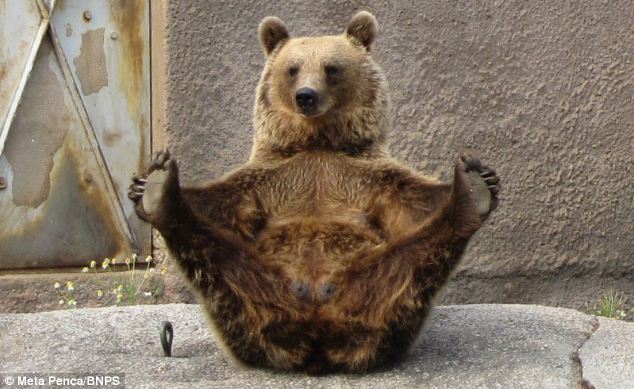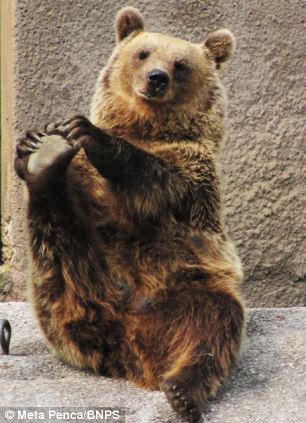Is there a better way to return to blogging after a long absence than by posting cute animal pictures? I didn’t think so.

A wide-leg version of Ubhaya Padangusthasana?
This is Santra, the Yoga Bear who recently mesmerized Finland’s Ahtari Zoo goers with a 15-minute yoga practice. You can read all about it – and see the rest of the pictures – on the excellent Yoga Dork blog.
Bystander Meta Penca, who took the pictures, was quoted in the UK’s Daily Mail, saying, “It was exactly the same as when you see people do yoga – easy, slow, focused and calm.
She looked pretty into it, a really straight face, no looking around just very serious and calm and kept her eyes slightly opened and focused. She looked like she didn’t notice us at all.”
Questions run rampant. Has Santra done this before? Does she have a daily practice? How many poses does she do? And then there’s the big one: what does it mean that a bear can settle and stretch using something that looks remarkably like yoga poses?
Dogs excel at downward facing dog. Cats are masters of savasana. Until squirrels start doing sun salutations, there’s probably no need for an explanation beyond “animals like stretching.”
Still, it’s a cause for wonder just how often body positions that are taught in yoga classes pop up in human and animal activities.
Erotic dance, gymnastics, acrobatics, Pilates, figure skating: once you know some poses, you see them everywhere.
I used to think that was because Hatha yoga was an ancient and highly developed practice that, in articulating the language of the body, had pretty much said all there was to say. Take a look at Dharma Mittra’s poster of 908 yoga poses and you too may wonder what else there is to do with a human body.
 But this summer I read Mark Singleton’s book Yoga Body: The Origins of Modern Posture Practice, and now I have no such illusions.
But this summer I read Mark Singleton’s book Yoga Body: The Origins of Modern Posture Practice, and now I have no such illusions.
As far as the physical work we do under the heading of asana, there is no 5,000-year-old tradition. There are no 84 poses prescribed by Patanjali, and there’s no lost text, the Yoga Kurunta, that outlines the Ashtanga practice.
For the details, read the book. It’s beyond fascinating.
For our purposes, all you need to know is that the popular Hatha yoga systems we practice today are an amalgamation of bodybuilding, European gymnastics, spiritual movement disciplines and yes, traditional postures. In the 1920s and 1930s, spurred on by Indian nationalism with input from eugenics and a worldwide craze for new physical disciplines, Hatha yoga flowered into the practices we do today.
This is disturbing news if, like me, you fondly thought that there was ancient wisdom in the poses.
Read novelist and Ashtanga practitioner Maya Lassiter’s blog for an exploration of how it feels to learn that a story of antiquity that you had, on some level accepted, turns out to be false. (Be sure to scroll down in the comments for Mark Singleton’s appreciative response.)
Like Lassiter, I’ve come to believe that it really doesn’t matter where the poses come from, or how widespread they are in other movement disciplines. Practice feels good, on more than a physical level. As one part of an eight-part system, posture practice is an essential foundation for what follows.
I believe that what powers every genuine movement is Dylan Thomas’s “force that through the green fuse drives the flower.”
Surely it can flower into Upavistha Konasana, or that wide-legged version of Ubhaya Padangusthasana that bears seem to favor, in any body, human or ursine.
So as long as Santra stays inwardly focused, and behaves like a good yoga student, we might as well call her a yogi.




Comments on this entry are closed.
All yoga practitioners should be clear-eyed about the origins of asana; it might be related to spiritual philosophy, but knowledge of one doesn’t translate into knowledge of the other.
E.g., a close friend, who happens to be Indian, says asana teachers who turn around and offer classes on the Bhagavad Gita are really mixing fields of study. He says that is akin to a university coach also teaching a course on religion/literature. Here, it is easy for yoga teachers to adopt various mantles of Indian “culture” because the public is ignorant and there is a cachet to all things “yoga.” But unless people are true scholars of the Gita or of philosophy, they should probably not deign to be experts (not that most folks do) (but I have seen some!).
Excellent post and priceless photos! Stephen Colbert, beware!
YogaSpy
http://yogaspy.com
PS You are 100% right about this: Dogs excel at downward facing dog. Cats are masters of savasana.
Took me a few days to open this! So glad I did! Inspired enough to roll my mat out and enjoy the calm centering of the pose.
thanks
Hey thanks, Elizabeth. Glad to hear it took you to your mat.
Good question. We know he did whiskey.
Did Dylan Thomas do yoga?